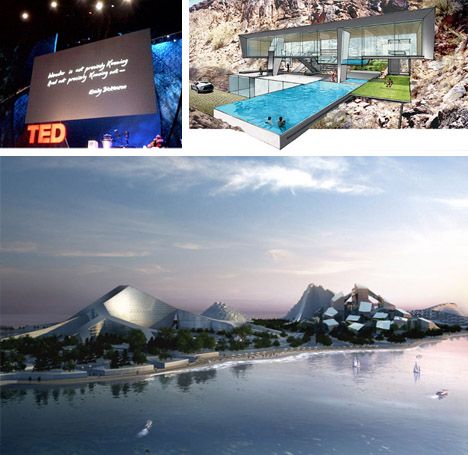Watch these videos and you will never see built environments in the same way again. Some tackle timeless questions of light, dark and color, while others address emerging technologies and the architectural problems of tomorrow. Skim the descriptions below to decide which you want to view – or take an hour of your day to enjoy them all!
Richard Kelly starts out with Le Corbusier’s modern classic Notre Dame du Haut in Ronchamp, illustrating the amazing plays of light and dark that together make for a deeply spiritual experience of space. He goes on to talk about Richard Kelly, a pioneer of lighting design, who talked in terms of focal glow (space-dominating sources), ambient luminescence (mood lighting) and plays of brilliants (bright points in a dark space). If you have any doubt about the importance of light and color in architectural design, you need to watch this video.
Daniel Libeskind is a designer who preaches what he practices. He abhors neutral and strives for inspirational, emotional, complex, risky, raw and story-telling architecture that both describes but also rises above the times in which it is built. At the same time, he is not a proponent of artistic expression for its own sake, but shows surprising pragmatism – architecture, like the Ground Zero memorial towers, should fit the consensus and respond to the needs of people occupying it. Whether or not you are a fan of his elaborate Deconstructivist-style monuments and institutions, this talk will help you put one of today’s most energetic architects in context.
Rachel Armstrong proposes self-repairing and evolving metabolic materials that will step beyond design and history. She boldly proposes that sustainability means connecting to nature in a fundamental way: namely, with building blocks that can grow and change. It is more than just a vision, though – she brings actual material developments to the table that defy the inert qualities of familiar concrete, wood and bricks. These can respond in real time to environmental conditions. Instead of imposing structure upon matter, these concepts, like what they contain, are necessarily dynamic – they will literally grow out of material science in the coming years.
Magnus Larsson has an improbable but grand project in mind, turning bacteria and grains of sand into a sandstone wall that could span the entire continent of Africa. Each second, one billion grains of sand are created in the world – some become sandstone, but others collect in dunes and deserts. Each day, the Saharan frontier moves a meter forward, taking over human-occupied lands and displacing populations. To reclaim vast and uninhabited areas of the Earth, it only makes sense that we turn the destructive desertification power of sand to our advantage. This proposal would have multiple benefits, reclaiming such spaces, reducing droughts and curbing climate change.
Bjarke Ingels asks how we tell the architectural design stories outside of the finished project, using alternative media (including comic books!) to talk about history, evolution and the avante garde of architecture. If you enjoy offbeat comparisons, visual juxtapositions, comedic concepts and experimental expression, this is a much-watch video.
Cameron Sinclair was and is an early proponent of open-source architecture to address everyday issues of sustainable global design, from emergency housing and transitional shelter to shipping container infrastructure, straw bale construction, mobile health clinics and more. This talk is now nearly a decade old, but the lessons are just as applicable today, or perhaps more so than ever.
Liz Diller (of Diller + Scofidio) describes architecture as a special-effects machine – beyond basic shelter, it is theatrical in essence. Her work challenges conventions of spatial use and building technology. Notably, she recognizes that her projects are not always easy to capture and display in museum retrospectives – they are about a time, place and experience, for better (and/)or for worse. This video should be a fittingly light-hearted end to these series of somewhat-heavy features.
